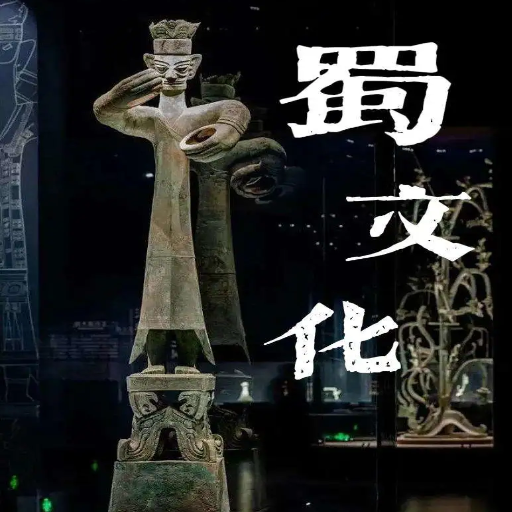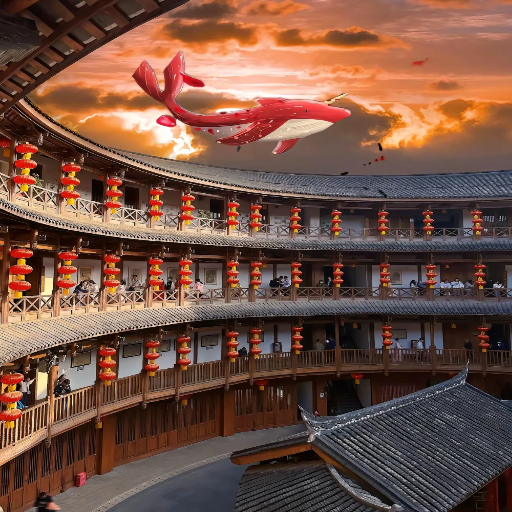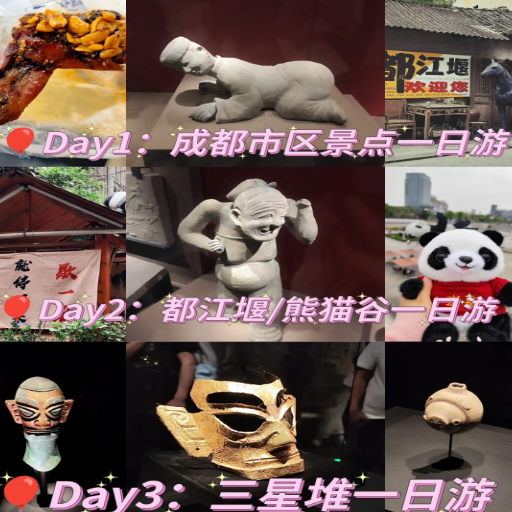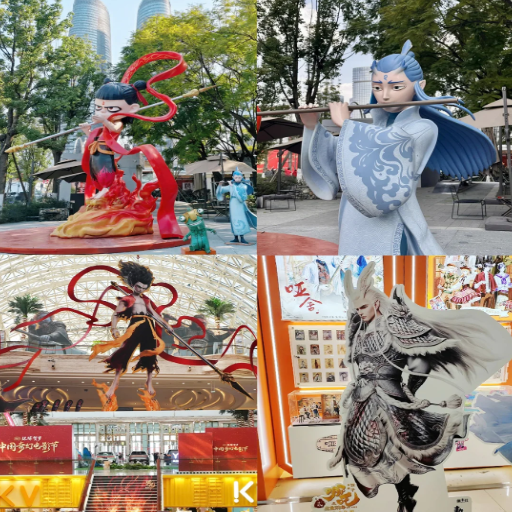The capital of Sichuan Province, Chengdu, is known for its rich and delicate culture, delicious cuisines, and adorable pandas; the city is famous for offering the best “tourist experience.” Chengdu looks forward to the traditional and modern aspects of the city, making Chengdu a must-visit. The town also features Chengdu’s rich cultural reliefs and the most loved giant pandas, making it a famous tourist destination. This blog is aimed at every traveler looking to experience Chengdu and provides tips for visiting its main attractions in 2025. With the inclusion of Sichuan’s well-known spicy hot pot, this cover takes you through the busy Chaklong market, ancient temples, and breathtaking landmarks. With our simplified guide, you are bound to discover the wonders of Chengdu, whether you’re a history nerd, a huge foodie, or a nature fanatic!
What Are the Top Panda Attractions in Chengdu?

What Are the Top Panda Attractions in Chengdu
Chengdu is known as the panda capital of the world and offers several attractions tailored for the beloved creatures. Starting with Chengdu Research Base of Giant Panda Breeding, where it is possible to view pandas of all ages in a human-made yet naturalistic setting and understand the infrastructure behind conservation. For more experienced visitors, we recommend the Dujiangyan Panda Base panda care volunteer programs. The Panda Post is located in downtown Chengdu, and it has the unique charm of selling panda souvenirs and postcards, which you can send right there. In addition to highlighting the city’s dedication to preserving pandas, the Chengdu Research Base offers one-of-a-kind experiences with pandas.
Exploring the Chengdu Research Base of Giant Panda
The Chengdu Research Base of Giant Pandas is a world-class center dedicated to studying and conserving giant pandas. It offers a realistic simulation of their natural habitat while supporting initiatives to increase their population. The base covers a fantastic 247 acres of land designed with bamboo and landscapes to help replicate the pandas’ native environment.
The primary facilities at the base are the Panda Nursery, which looks after the cubs, and the Giant Panda Museum, which holds enormous collections focused on the particular animal’s history, biological makeup, and conservation activities. At the base, there are over one hundred giant and red pandas, which makes it possess one of the largest captive populations of these species. More than a hundred captive pandas breathe in the fresh air of red canyons. The base focuses on sustainable operations, waste recycling, and renewable energy sources.
Most people visit the base to see the Giant Pandas, and they will be in the best mood during feeding times, which are in the morning from 8:00 AM to 10:00 AM. The base is also infamously known for having giant panda cubs, and every year, children similar to black and white teddy bears are born. Other than seeing the charming pandas and cubs, there is an entry fee of about 58 RMB that most likely all instantly pay without consideration.
Visiting the Chengdu Panda Base: A Comprehensive Guide
The Chengdu Research Base of Giant Panda Breeding is a dreamlike destination for wildlife lovers and tourists. Here, you can observe some of the world’s cutest pandas in their pseudo habitats while learning about wildlife conservation and soaking in the beautiful scenery.
How to Get There
The Base is approximately 10 kilometers (6.2 miles) from Chengdu’s city center. It is easily accessible by various modes of transport:
- Taxi: Around 30-50 RMB with a 25-30 minute travel time.
- Public Bus: Bus routes such as 87, 655, or tourist bus lines include stops near the Panda Base.
- Metro-Bus Combo: Take Metro Line 3 to Xiongmao Avenue Station, then transfer to a shuttle bus directly to the Base.
Best Visiting Times
You can visit the park every day between 7:30 a.m. and 6 p.m., with the last admission at 5 p.m. The morning is best, specifically between 8 a.m. and 10 a.m., when the pandas are most active, especially during feeding.
Ticket Information
Ticket prices are 58 RMB (roughly USD 8) for general entry, and children under 6 years old or under 1.3m tall can enter for free. Tickets can be purchased onsite or through many online third-party sites, which is gratifying.
Panda Conservation and Research
The Red Panda Center and other endangered animals have more than 200 pandas and two species. The Red Panda Center provides education and public outreach about preserving pandas for future generations and breeding programs to help conserve their population.
Facilities and Activities
- Panda Museum: Explore exhibits on panda biology, habitat, and conservation efforts.
- Scenic Trails: Walk along beautifully landscaped paths surrounded by bamboo groves and lakes.
- Panda Cafe and Souvenirs: Enjoy local snacks and pick-up-themed mementos.
Eco-Friendly Initiatives
The Chengdu Panda Base makes sustainability a top priority. Here are some of their eco-friendly initiatives:
- Renewable Energy Usage: Solar panels provide power for some facilities.
- Recycling Programs: Waste and water are efficiently recycled to minimize the environmental footprint.
- Green Transportation: Eco-friendly shuttle buses operate within the Base.
Travel Tips
- Arrive early to avoid crowds and maximize your time.
- Comfortable shoes are recommended due to the extensive walking paths.
- Respect the rules, such as keeping quiet near panda enclosures and not using flash photography.
Taking a trip to the Chengdu Panda Base is an incredible experience by itself, and it also allows you the unique chance to help protect pandas, one of the world’s most loved and endangered animals.
Tips for a Memorable Panda Encounter in Chengdu
Here are some of my guidelines to help freshen your memories of pandas in Chengdu:
Coordinate Your Visit With Feeding Schedules: Note the panda’s feeding schedule, usually between 8:30 and 10:30 a.m. Ensure you are there early, as they are most active around that time.
Select the Correct Season: The moderate weather conditions during Spring and Fall are excellent for the pandas and for people visiting to enjoy the lush environment.
Remember To Stay Hydrated. Sunscreen and water are essential for staying outside for a long time. Most areas provide shade, but the sunny paths are hot, and some protection is required.
Photography Advice:
To avoid disturbing the pandas, use a zoom lens. A 70 mm-200 mm or higher lens is perfect for these shoots.
Flash photography is a big no when dealing with animals since it startles them, so try to avoid it at all costs.
Find Out About Conservation Work: While there, check out the educational exhibits on panda enrichment and conservation. They are very informative.
Once you prepare yourself by following all these tips, you will truly appreciate and respect the pandas and their natural habitat.
How to Experience Authentic Sichuan Culture?

How to Experience Authentic Sichuan Culture
To truly experience Sichuan culture, immerse yourself in the incredible local customs and traditions. Start by indulging in Sichuan’s world-famous cuisine. Sichuan’s culinary highlights are its fiery flavors, which are also enjoyed in Mapo Tofu and Hot Pot. Observe local social customs by sipping tea in traditional teahouses. Don’t forget to stroll through Chengdu and Leshan’s historic street wonders, such as the Leshan Giant Buddha. Witnessing a Sichuan opera performance is a must as it showcases breathtaking face-changing, a unique performing arts skill of the region. Lastly, visit local markets and workshops to appreciate Sichuan’s famed embroidery and bamboo “weaving” and admire the local craftsmanship.
The Magic of Sichuan Opera
Sichuan opera is centered on and is an eclectic, vibrant form of traditional Chinese theater decorated with stunning costumes, powerful masks, and elaborate storytelling. One of its most famous features is the “Bian Lian” face-changing performance, where actors instantly change masks to new and different emotions or characters. This excellent combination of speed, magic, and body placement creates stunning visuals that amaze viewers.
Sichuan opera and traditional Chinese music played with jinghu (two-stringed fiddle), pipa (four-stringed lute), and gongs contribute to the soundscape. Typically, shows are presented on an essential backdrop, which helps the actors’ intricate costumes and makeup stand out more.
While some modern-day technology has been incorporated to improve the visual aspects of performances, the core of the art form is still deeply concerned with preserving traditional, authentic ways of doing things.
Discovering Sichuan Cuisine: Top Dishes to Try
Acclaimed for its powerful aromas and delightful flavors, Sichuan province is home to some of the best dishes and treasures. Here’s the epic showdown of the mouth-watering dishes that take first place:
- Mapo Tofu
Have you ever heard of a silky tofu dish paired with minced meat? It’s topped with red chili pepper paste sauce, Sichuan pepper, and black beans, and you’d be shocked to learn that it also contains honey. The best part is that it tastes great when paired with steamed rice.
- Kung Pao Chicken
If you ever need hypnotizing flavors, tender chicken, green onions, dried peppers, peanuts, or whatever you throw in a pan, it’s bound to come out great. Besides the easy prep, this dish tastes iconic when stir-fried with a tangy, sweet taste that complements the spice.
- Twice-Cooked Pork
Those in dire need of adding more depth in flavor infused with strong meat would never regret trying finely cut pork belly paired with an infused pepper cap or green pepper sauce. The balance of chewy, sort, rich meat promised to linger on the taste buds and spice up the experience.
The food is prepared using advanced Sichuan methods, fresh ingredients, and balanced flavors. The hallmark of this vessel’s cuisine is the loved region of “mala,” which highlights the feeling of heat and numbness. For the right experience, enjoy these alongside soothing dishes such as tea or unseasoned steamed veggies.
Understanding the Heritage at the Wuhou Shrine
As a place of remembrance for Zhuge Liang, the Shu strategist during the Three Kingdoms period, and Liu Bei, the emperor of Shu Han, the Wuhou Shrine holds great significance in Chengdu. It certainly captures the beauty of the bygone eras. It was Zhuge Liang who enabled Shuhan to bask in glory over their enemies, which is the Elesh empire, and with such remembrance, it would be the best idea to dwell in the serene gardens and halls of the Shrine. Its history can be felt in the traditional wooden pavilions and stone sculptures, which are the Wuhou Shrine’s main attractions. The intricate architecture serves to showcase the artistry of that period. The exhibits contain historical relics, calligraphy, and other loyalty and wisdom-provoking artifacts serving as modern telling tools. Measuring over thirty-seven thousand square meters of area, the shrine is highlighted by the Liu Bei Mausoleum, Hall of Zhuge Liang, and The Gallery of Three Successors, all blending heritage and storytelling so seamlessly that it’s breathtaking. The destination stands out as an immersive experience full of depth and richness.
Which Historical Attractions Should You Visit in Chengdu?

Which Historical Attractions Should You Visit in Chengdu
Wuhou Shrine
Wuhou Shrine is an iconic landmark in Chengdu, China, commemorating the three kingdoms’ periods. It is dedicated to Liu Bei, Zhuge Liang, and several other historical figures and serves as a cultural treasure combining history, architecture, and folklore.
Dujiangyan Irrigation System
A site adopted by UNESCO as a World Heritage Site, the Dujiangyan Irrigation System is a wonder of ancient engineering due to its construction over 2000 years ago. This site is proof of ancient Chinese hydrology and showcases their creativity; what’s marvelous is that it remains functional.
Jinsha Site Museum
This museum illustrates the achievements acquired by the Shu Kingdom in the ancient Zhou dynasty through a collection of gold masks, jade artifacts, and bronze relics. It is an astounding representation of Chengdu’s ancient past, and its features make it a must-visit site.
Qingyang Palace
This Place is known as one of the oldest in China. Built during the Tang Dynasty, Qingyang Palace is a spectacular sight overflowing with spiritual energy. It is a marvel of inter-character intricacies paired with the immense history that lies within, adding to the beauty of Chengdu.
A Guide to the Leshan Giant Buddha
Situated in the Sichuan Province, The Leshan Giant Buddha is a site of extreme value as it is the largest stone Buddha in the world and a statue listed on a UNESCO World Heritage Site. An exceptional example of ancient engineering and artistry is carved on a cliff where the Min, Dadu, and Qingyi rivers meet. Here’s a closer look at the statue with some intriguing details:
1. What is the height of the Leshan Giant Buddha?
The statue is astonishingly tall, at 71 meters (233 feet), with a head of 14.7 meters (48 feet) high. Its shoulder width is also 24 meters (78.7 feet). Only the fingernails are 1 meter (3 feet) long. For some reason, the world cannot get enough of this statue.
2. When was it constructed?
713 AD was the year the Buddha started being crafted during the Tang dynasty, and all details were wrapped up in 803 AD. Completing it required 90 years – showcasing ancient craftsmen’s steady and hardy spirit, which many people admire and look up to.
3. What is its purpose?
The statue was meant to soothe the volatile waters at the river junction, which could be dangerous for ships to pass. People also used to visit the statue with wishes to be blessed and to find calmness, making it a significant spiritual and cultural symbol.
4. What materials were used in its construction?
The Leshan Giant Buddha was cut from the red sandstone cliff. Over many years, intelligent drainage systems were built into the structure to prevent water erosion and damage.
5. Why is it significant?
The Buddha’s extraordinary size is not the only reason to visit it; it is also a cultural and spiritual masterpiece. It stands for ancient Buddhist artistry and captures the period’s incredible architecture for handling such a huge endeavor.
A visit to the Leshan Giant Buddha brings you face-to-face with a historical marvel that offers breathtaking views of the rivers and cliffs on all sides.
Unveiling the Mysteries of Wenshu Monastery
Located in the bustling Chengdu city, the Wenshu Monastery is a must-visit place if you are interested in Buddhism. The stunning architecture surrounding this site, along with the rich history, is something to captivate anyone. Monastery was established during the Tang dynasty, and nowadays, it resides on a colossal area of 200,000 square meters. The Monastery also contains over 500 cultural relics, like paintings, exquisite calligraphy, and sculptures from Buddha.
I was most impressed by the layout, which consisted of 5 significant halls that followed traditional Chinese architecture. These buildings emerge within beautifully maintained gardens, creating a tranquil experience for tourists and visitors. The ingenuity of Chinese construction magic is beyond belief. Simple details like precise wood joinery methods without nails and the order of halls aligned with the axis demonstrate this. Nonetheless, if you seek spiritual enlightenment or love analyzing history, Wenshu Monastery is a remarkable example of Buddhism’s legacy.
The Ancient Charm of Huanglongxi Ancient Town
Wandering around Huanglongxi Ancient Town was like traveling back in time, where one could feel the history and culture. The architecture from the Ming and Qing dynasties is beautifully preserved, and the town boasts cobblestone streets, wooden houses, and peaceful water bodies, which give it a mesmerizing charm. While walking around the city, I also enjoyed the lively local markets and the mesmerizing performances of traditional Sichuan opera. Every alley is unique, with incredible carvings on the doors and windows.
Most of these ancient structures are built using ancient Chinese engineering techniques incorporating traditional wooden frameworks without modern-day nails, allowing for greater structure flexibility and resilience. Huanglongxi town’s unique layout includes three ancient temples, six ancient trees, and nine interconnected winding streets. The city has a rich history and culture, making Huanglongxi unique, from tasty spicy street food to stunning historical relics.
What are the best day trip destinations In Chengdu?

What are the best day trip destinations In Chengdu
Mount Qingcheng
Mount Qingcheng is a fantastic place for those who love nature and wish to learn about Taoism. It is full of greenery and ancient temples, making it a perfect escape from daily life.
Dujiangyan Irrigation System
The misconception is that the irrigation system is an ancient piece of engineering that is over 2000 years old and still functions today. However, it has also earned the designation of a UNESCO World Heritage site. This astonishing site is remarkable in scenic landscape and cultural significance and is a must-visit.
Leshan Giant Buddha
One of the largest Monolithic stone statues of Buddha in the world, standing at a towering view of 71 meters, the Leshan giant Buddha is a sight to behold when you visit Chengdu and is situated at the confluence of three rivers. Not only does this region act as a prominent tourist hub, it is also rich in history.
Panda Base at Wolong
The Panda base at Wolong is situated amid calm forests and towering mountains. It is the perfect destination for wildlife lovers, who can witness the fabulous beasts in their natural habitat and learn about various conservation methods.
Exploring the Dujiangyan Irrigation System
Situated in Sichuan Province, the Dujiangyan Irrigation System is a world-famous engineering feat completed over 2000 years ago in the Qin Dynasty. It still functions today, demonstrating how ingenious and sustainable its construction was. Unlike regular dams, this irrigation system controls the flow of the Xinjiang River without blocking it by using the river for its natural purpose.
Key Features:
- Fish Mouth Levee (Yuzui): This curved dike divides the river into inner and outer streams, receiving 40% and 60% of the flow. The water from the inner stream is used for irrigation, while the water from the outer stream is retained to prevent flooding.
- Flying Sand Weir (Feisha Yan): This weir diverts excess water and sand from the inner canal into the outer channel, ensuring a smooth water balance.
- Bottle-Neck Channel (Baopingkou): A narrow, manually dug channel that enables control of water volume and pressure flowing into the irrigation areas downstream.
Modern Relevance:
The Dujiangyan irrigation system can irrigate over 5,300 square kilometers of farmland, significantly improving agricultural output. It is also beneficial in flood management and dealing with ecological issues, providing examples of sustainable engineering that other projects should aspire to. Due to its historic importance and practicality, the system is a technological marvel and a cultural landmark.
Hiking Adventures at Mount Qingcheng
Mount Qingcheng, a blend of nature resoluteness and spiritual profundity, is perfect for hiking and is famous for being Taoism’s birthplace. It is split into two parts: Front Mountain and Back Mountain. Front Mountain has beautiful Taoist temples, cultural relics, and scenic views, making it easier to access than Back Mountain. Back Mountain also has tranquil and rugged hiking paths, perfect for mountain enthusiasts.
Remarkable hiking features besides the Back Mountain include Jianfu Palace, The Tianshi Cave, and the Laojun Pavilion. These striking locations have unique features, breathtaking views and rich historical significance intertwined with ancient Taoist rituals.
- Trail Difficulty: Easy to Moderate (Front Mountain); Moderate to Hard (Back Mountain)
- Trail Length: Front Mountain approximately 5 kilometers; Back Mountain up to 16 kilometers, depending on the route
- Average Hiking Time: 3-4 hours (Front Mountain); 5-7 hours (Back Mountain)
- Elevation: The peak elevation at Laojun Pavilion is 1,260 meters
- Best Time to Visit: March to November for mild weather and enhanced scenic beauty
Wary hikers should consider protective gear, proper gear, sufficient drinking water, and suitable clothing for potential temperature changes. Mount Qingcheng is a renowned place for many tourists, thanks to the blend of cultural history, spiritual peace, and scenic greenish beauty. It also attracts advanced hikers with its charmingly breathtaking scenery.
Relaxing Getaways Near Chengdu: Luodai Ancient Town
Luodai Ancient Town is an old Hakka settlement that is well preserved and is a good escape from the Chengdu city life. The town is a fusion of cultural heritage, traditional architecture, history, and modern charm, making it suitable for a day trip. Exploring its colorful streets, one can gaze at the extraordinary wooden crafted sculptures and ancient sculptures and feast on the delicious Hakka food. Other highlights are the stunning Guangdong Guild Hall, which shows the beauty of Hakka architecture, and the tranquil Dragon Town Lake.
- Distance from Chengdu: Approximately 20 kilometers (roughly a 40-minute drive)
- Recommended Visit Duration: 3-5 hours
- Best Time to Visit: Spring and autumn for comfortable weather and a lively atmosphere
- Key Activities: Sightseeing, enjoying local cuisine, and experiencing traditional Hakka performances
With its beautiful views, Luodai Ancient Town combines cultural scrutiny and relaxation, offering a tranquil yet extraordinary escape.
Where to Find the Best Things to Do in Chengdu?

Where to Find the Best Things to Do in Chengdu
Chengdu guarantees an exceptional experience, providing a unique blend of culture, history, and nature. The Wuhou Shrine and Jinsha Site Museum showcase the city’s remarkable history, which is ideal for history buffs. As for nature enthusiasts, the Chengdu Panda Base and People’s Park are worth a visit. Lastly, for food lovers, Jinli Street and Kuanzhai Alley are the epitomes of Sichuan cuisine. Also, the local artistic performances will surely impress at the Sichuan Opera. Whether looking for peace or a complete adrenaline rush, Chengdu has it all.
A Stroll Through Jinli Old Street
Jinli Old Street is yet another vibrant place where the historical beauty of Chengdu is perfectly integrated with its modern culture. It is famous for its narrow, cobble-stoned streets and the traditional architecture of Sichuan. As you walk through the street, local craft stores sell handmade crafts such as silk products and shadow puppets. Spice lovers are in for a treat, as authentic Sichuan snacks such as spicy tofu, sweet dumplings, and glazed fruits are also offered. Be sure to visit the traditional tea houses where you can enjoy the calmness of the bustling city. These areas serve as the hub for local performances, including face-changing and the Sichuan Opera, which adds to the city’s culture. From shopping to simply enjoying the low-keyed, vibrant energy of the town, everyone is sure to have a unique experience.
Uncovering Secrets at the Jinsha Site Museum
The Jinsha Site Museum in Chengdu is a gateway to the ancient Shu civilization, which dates back over 3000 years to the Late Shang and Early Zhou dynasties. This site, discovered in 2001, is known for its archeological excavations, which have revealed more than 6,000 artifacts crafted from gold, jade, bronze, stone, and ivory. The Sun and Immortal Bird gold foil is the most renowned of these. It represents ancient Chinese art and heritage; thus, this piece of jewelry is regarded as a cultural treasure.
The Museum covers about 300000 square meters and is divided into sections, such as an eco-garden, exhibition galley, and an excavation hall. In the excavation hall, visitors will have the chance to learn about the preserved remains of sacrificial pits and relics in situ. The exhibition gallery displays distinctive artifacts like gold masks, jade weapons, and ivory carvings, demonstrating the Shu people’s advanced craftsmanship.
The Jinsha Site, famous for its ancient Shu civilization relics, is a tourist attraction incorporating eco-garden features to beautify the region while protecting its delicate landscape. Modern climate control systems coupled with advanced material analysis techniques ensure maximum preservation of the relics. The site is an unmatched blend of geography, art, and technology, making it a must-see for tourists and locals alike.
Fun Things to Do in the Heart of Chengdu: People’s Park
People’s Park represents a Chengdu city site enriched with history, heritage, and a lively atmosphere. One of the most striking features of Chengdu is its tea, and during my visit, the exquisite Chengdu-style tea served at local teahouses was exceptional. In the traditional Chengdu style, tourists can also experience ear-cleaning, which is unique to local culture. For a more profound cultural connection, take a walk around the historic pavilions that can be found throughout the park, including the serene lakes that are perfect for paddle boating. Additionally, visitors can participate in local recreational activities such as Tai Chi or group dancing and enjoy the culture firsthand.
Chengdu is widely known for its affordable friendliness, making places easy for people of all ages to visit. If you visit in autumn, the Chrysanthemum exhibition is a most spectacular experience that is hard to miss.
References
Frequently Asked Questions (FAQ)
Q: What are the top attractions to visit in Chengdu in 2025?
A: During your trip to Chengdu, you shouldn’t miss the top attractions like Jinli Ancient Street, the Chengdu Museum, and the Base of Giant Panda Breeding. These locations offer a glimpse into Chengdu’s rich history and culture and opportunities to see the adorable pandas.
Q: How can I efficiently explore Chengdu?
A: To explore Chengdu efficiently, consider using the Chengdu Metro for quick and easy transportation around the city. A well-planned itinerary can help maximize your visit, allowing you to experience the best places, such as Kuanzhai Alley and the Chengdu Culture Park.
Q: What are some must-see Chengdu attractions for first-time visitors?
A: First-time visitors to Chengdu should explore the Jinli Ancient Street to taste traditional Chinese culture, visit Mount Emei for spiritual and natural beauty, and see the pandas at the Base of Giant Panda Breeding.
Q: Are there any cultural activities in Chengdu that you can enjoy?
A: Chengdu is a city rich in cultural activities. Visitors can enjoy performances at the Chengdu Culture Park, explore the historical Chengdu Museum, and appreciate the city’s designation as a City of Gastronomy by experiencing its diverse culinary offerings.
Q: What is the best time of year to travel to Chengdu?
A: The best time to visit Chengdu is spring (March to June) or autumn (September to November), when the weather is mild. This makes it ideal for visiting outdoor attractions like Jiuzhaigou and Mount Emei.
Q: How can I see the pandas during my Chengdu trip?
A: To see the pandas, visit the Base of Giant Panda Breeding outside Chengdu. This facility provides a natural environment in which to see and learn about China’s beloved national treasure.
Q: What are some places to visit outside Chengdu?
A: Outside Chengdu, you can explore the stunning landscapes of Jiuzhaigou and the sacred Mount Emei, among the most beautiful natural and cultural sites in Southwest China.
Q: Is Chengdu a good starting point for a tour around Southwest China?
A: Chengdu is an excellent starting point for a Southwest China tour. Its location in the Chengdu Plain and its connectivity to other major destinations, such as Jiuzhaigou and the mountains, make it ideal for further exploration.
Q: How does Chengdu’s history influence its current attractions?
A: Chengdu’s rich history as one of China’s oldest cities is reflected in its current attractions. Sites like the Jinli Ancient Street and the Chengdu Museum highlight the city’s historical significance and role in fostering Chinese culture.
Q: What makes Chengdu unique compared to other Chinese cities?
A: Chengdu is unique for its mix of traditional and modern influences. Known as the City of Gastronomy, it offers culinary delights that reflect its diverse heritage. Chengdu’s relaxed atmosphere and vibrant cultural scene stand out among Chinese cities.